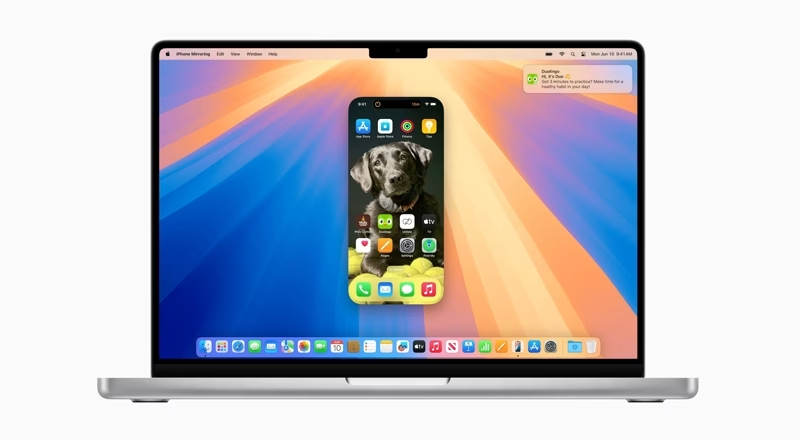The EU's Mirror Image Problem: Why iPhone Mirroring Still Eludes macOS 26 Tahoe Users
It's a familiar refrain for Apple users in the European Union, isn't it? Another year, another major macOS release, and still, a highly anticipated feature remains conspicuously absent. We're talking, of course, about iPhone Mirroring on macOS 26 Tahoe, a capability that's been part of Apple's broader ecosystem for a while now, yet continues to be a phantom for those of us within the EU's borders. Just yesterday, a report from MacRumors, a source I personally trust for timely Apple news, confirmed what many suspected: no iPhone Mirroring for EU users on Tahoe. It begs the question, why?
What We're Missing Out On: The Power of iPhone Mirroring
For those unfamiliar, iPhone Mirroring isn't just about casting your phone's screen to your Mac. Oh no, it's far more integrated than that. It allows you to fully interact with your iPhone directly from your Mac's desktop. Imagine this: you're deep into a workflow on your Mac, perhaps editing a document or responding to emails, and a notification pops up on your iPhone. Instead of reaching for your phone, you can simply click on the mirrored display on your Mac, open the app, respond to messages, browse photos, or even play a game – all without breaking your concentration on the larger screen. It's a productivity dream, a seamless bridge between two core Apple devices.
The Digital Markets Act: Apple's Regulatory Tightrope Walk
Think of it like this: the EU sees Apple's tightly integrated ecosystem as a walled garden. The DMA is essentially a mandate to build more gates, and perhaps even open some of those walls, to allow other players in. For Apple, a company built on controlling the end-to-end experience, this is a significant challenge. The concern, as speculation on platforms like X (formerly Twitter) and Reddit suggests, is that if Apple enables iPhone Mirroring in the EU, the DMA might then compel them to offer similar functionality for other platforms. We're talking about Android devices, for instance.
The Interoperability Sticking Point
And that, my friends, is the real sticking point. If Apple were forced to ensure iPhone Mirroring could work seamlessly with, say, a Samsung Galaxy phone, the engineering challenges would be immense. Not only that, but it would fundamentally alter the "Apple experience" they've meticulously crafted. Their ecosystem's strength lies in its tight integration, which is often cited as a key reason users stay within the Apple fold. Forcing them to open up core functionalities like mirroring to competing platforms could, from Apple's perspective, dilute that unique selling proposition and potentially compromise security or performance.
It's a classic innovator's dilemma, isn't it? Innovate with proprietary features, but then face regulatory pressure to share the fruits of that innovation.
A Familiar Pattern: Not the First Time, Won't Be the Last?
This isn't the first time we've seen Apple pull back features or alter their approach in the EU due to regulatory pressure. Cast your mind back to the introduction of iOS 18.4; iPhone Mirroring was also notably absent in the EU then. This consistent pattern across both iOS and now macOS 26 Tahoe suggests a deliberate, calculated strategy by Apple. They're clearly prioritizing compliance (or avoiding non-compliance penalties) over offering a full feature set to their EU customer base.
The discussions on Reddit and X have been buzzing with this for months. Users are frustrated, yes, but there's also a growing understanding of the complex dance Apple is performing with the EU regulators. It's not just about Apple being stubborn; it's about navigating a regulatory environment that's actively seeking to reshape how tech giants operate.
The Broader Implications: A Shifting Tech Landscape
The unavailability of iPhone Mirroring in the EU for macOS Tahoe is more than just a missing feature; it's a microcosm of the ongoing tension between tech innovation and regulatory oversight. For EU consumers, it means a less integrated experience than their counterparts in other regions. This regional disparity could, over time, influence consumer choices or perceptions of Apple's commitment to its European market.
For Apple, it's a constant balancing act. How do you maintain your competitive edge and the integrity of your ecosystem while adhering to increasingly stringent regulations? It's a question that will continue to shape product development and feature rollouts for years to come. And honestly, I don't envy their position. It's a tough spot to be in, trying to innovate while simultaneously navigating a legal minefield.
Ultimately, until Apple finds a way to satisfy the DMA's demands regarding interoperability, or until the regulations themselves evolve, it seems EU users will continue to look longingly at the iPhone Mirroring feature available elsewhere. It's a stark reminder that in today's global tech landscape, innovation doesn't happen in a vacuum; it's deeply intertwined with policy and politics.
